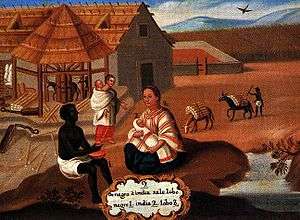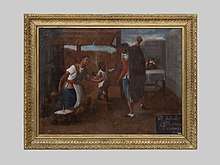Lobo (racial category)
Lobo (fem. Loba), (Spanish for "wolf") is a racial category in the Spanish colonial racial label for a mixed-race casta, far down the racial hierarchy created by the Spanish colonial regime privileging European whites.


Definitions
Lobo and coyote are derogatory animal names for persons of mixed race. Lobo does not have a fixed meaning, with possible parents being a Black and Indian woman; Cambujo and Indian woman; Torna atrás and Indian woman; Mestizo and Indian woman; Salta atrás and Mulatto woman.[1] Lobo was a real classification in official colonial documentation, including the Inquisition trials, marriage registers, and censuses.[2] One example of a Loba is a mixed-race woman who came before the Mexican Inquisition who had multiple racial labels. She was publicly known as a China, was known to be a parda (darked skinned person) who “looked like a loba”.[3]
Lobos were known to be enslaved persons in seventeenth-century Mexico, likely with the mother being a Negra. The status of a child as slave or free followed the mother.[4] In historian Ben Vinson III’s analysis of what he calls “extreme racial categories,” he includes lobos with castizos, moriscos, albinos, coyotes, "mestindios", and chinos.[5] There were regional differences in colonial Mexico for racial labeling. Lobos were particularly prevalent as a “normative category” in Xichú and Casas Viejas in the Bajío region near Querétaro and the Sierra Gorda mountains, where there were resident indigenous populations as well as blacks and mulattos.[6]
In his examination of marriage patterns from marital registers, there were no records of lobos marrying each other; brides and grooms chose partners from other racial categories.[7] In eighteenth-century casta paintings, lobos are usually shown doing physical work and not lavishly dressed. In Joaquín Antonio de Basarás’s Origen, costumbres, y estado presente de mexicanos y philipinos (1763), the lobo father is a water carrier, while his Indian wife sells chickens.[8] An early 18th century set of casta paintings shows the Lobo as the offspring of a Black father and India mother; in the same set, a Lobo father and an India mother produce a dark-skinned child labeled a Lobo Torna atrás.[9]

A set of casta paintings by Andrés de Islas is typical in the order and combinations of races.
- De Español e India, Mestizo (European white and Indian woman, Mestizo
- De Español y Mestiza, Castizo (European white and Mestiza, Castizo
- De Castizo y Española, Española (Castizo and Spanish woman, Spanish woman)
- De Español y Negra, Mulata (Spaniard and Black woman, Mulatta
- De Español y Mulata, Morisco (Spaniard and Mulatta, Morisco (light-skinned person of African ancestry)
- De Español y Morisca, Albino (Spaniard and Morisca, Albino (lightest-skinned person of African ancestry)
- De Español y Albina, Torna atrás (Spaniard and Albina, Torna atrás ("throw back" to blackness))
- De Indio y Negra, Lobo (Indian man,black woman, Lobo "wolf")
- De Indio y Mestiza, Coyote
- De Lobo y Negra, Chino
- De Chino e India, Cambujo
- De Cambujo e India, Tente en el aire
- De Tente en el aire y Mulata, Albarazado
- De Albarazado e India, Barcino
- De Barcino y Cambuja, Calpamulato
- Indios Mecos bárbaros (Barbarian Meco Indians)
References
- García Saiz, Maria Conception. Las Castas Mexicanas: Un Género Pictórico Americano. Milan: Olivetti 1989, pp. 28-29.
- Katzew, Ilona. Casta Painting. New Haven: Yale University Press 2004, p. 44.
- quoted in Vinson, Ben III. Before Mestizaje: The Frontiers of Race and Caste in Colonial Mexico. New York: Cambridge University Press 2018, pp. 64-65
- Vinson, Before Mestizaje, p. 70.
- Vinson, Before Mestizaje, p. 92.
- Vinson, Before Mestizaje, pp. 98-99.
- Vinson, Before Mestizaje, p. 128
- Katzew, Casta Painting, pp. 186-87, illustration 248.
- García Saiz, ‘’Las Castas Mexicanas’’, pp. 58, 59.
Further reading
- García Saiz, Maria Conception. ‘’Las Castas Mexicanas: Un Género Pictórico Americano’’. Milan: Olivetti 1989.
- Katzew, Ilona. ‘’Casta Painting: Images of Race in Eighteenth-Century Mexico’’. New Haven: Yale University Press 2004.
- Vinson, Ben III. ‘’Before Mestizaje: The Frontiers of Race and Caste in Colonial Mexico’’. New York: Cambridge University Press 2018